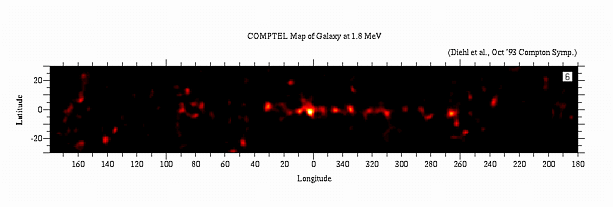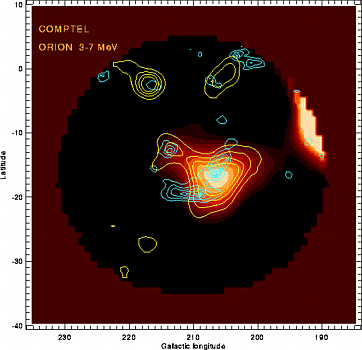

Figure 2.1.2 - Galactic map of the 26Al - 1809 keV line as seen by
COMPTEL. A tracer of recent (106yr) nucleosynthesis.
In addition to the galactic longitude and latitude distribution of the
1.809 MeV line emission, information on the origin of the 26Al can also
be obtained from studies of the shape of the line. Surprisingly, large
Doppler broadening of the line has recently been observed with a balloon-borne
gamma-ray instrument GRIS, implying velocities of about 400 km/sec, much
larger than that expected from galactic rotation. This suggests that the
emitting 26Al may be in high-velocity grains precipitated from supernova
ejecta. Future observations by INTEGRAL should provide a much better understanding
of the origin of the radioactive aluminum and of the chemical evolution
of the galaxy. The same models that agree with the observed 26Al signal
also predict a strong signal from 60Fe, another long-lived nucleus (J1/2
= 1.5x106 y) made in Type II supernovae. The mass of 60Fe predicted is
1.7 ± 0.9 Mo implying a signal about 15% as strong as 26Al. This
is on the edge of what can be currently detected but should be visible
to INTEGRAL. The diffuse galactic 0.511 MeV line from positron annihilation,
which has been extensively observed from the galactic center region, is
the most luminous gamma-ray line in the galaxy. The positrons responsible
for this emission are most likely from the decay of the radionuclei 56Co,
44Ti and 26Al resulting from various processes of galactic nucleosynthesis.
2.1.3 INTERSTELLAR PROCESSES The recent discovery of gamma-ray emission
lines from the Orion giant molecular cloud complex has revealed exciting
new particle acceleration processes in this nearest region of recent star
formation. This has very important implications for light element nucleosynthesis.
Gamma-ray line emission in the 3 to 7 MeV range was observed from the Orion
complex with COMPTEL. The radiation shows emission peaks near 4.4 and 6.1
MeV, consistent with the de-excitation of excited states in 12C and 16O
produced by accelerated particle interactions. Moreover, the intensity
of these lines is roughly two orders of magnitude greater than that expected
from irradiation by low-energy cosmic rays with energy density equal to
that of the local galactic cosmic rays.
This emission requires that the ambient matter in Orion, both gas and dust,
is undergoing bombardment by an unexpectedly intense, locally accelerated,
population of energetic particles. The present rate of energy dissipation
of the particles in Orion is about 5x1038 erg s-1. The most likely source
of this energy is the ~80,000-year old supernova which is thought to be
responsible for the Orion-Eridanus bubble. If such particle fluxes also
exist in other massive star formation regions, their interactions could
be the major source of light element (6Li, Be & B) nucleosynthesis
in our galaxy.

Figure 2.1.3 - 12C & 16O Line emission from Orion star formation
region which traces cosmic ray interactions in molecular clouds.